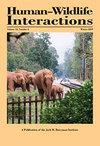影响野猪对松木苗木危害的生态因素
IF 0.9
4区 环境科学与生态学
Q4 BIODIVERSITY CONSERVATION
引用次数: 5
摘要
美国南部野猪(Sus scrofa)种群的扩大有可能影响长叶松(Pinus palustris)的恢复工作。在人工林中,野猪造成的最广泛和最昂贵的经济损失是对人工松苗的掠夺。更好地了解影响掠夺率的生态因素将使管理者能够实施最佳管理措施,以减少野猪生长最脆弱阶段的幼苗死亡率。2016年3月至2017年3月,在美国阿拉巴马州布洛克县34.4公顷的插枝地和4.7公顷的山核桃果园中,研究了野猪对人工种植松木和硬木的偏好。野猪对5种幼苗的危害不同,以长叶栎和樱桃栎(Quercus pagodaefolia)最受欢迎。被野猪破坏的苗木有91%来自扦插地。与其他地点的野猪相比,交接点的野猪经历了更大的狩猎压力。我们认为,伐木工人在砍伐后将碎片分散的做法创造了一个理想的觅食环境,导致了幼苗的最初发现。短期保护和尽量减少对幼林幼苗的掠夺可能是减少野猪对林业和木材资源影响的最现实的解决方案。本文章由计算机程序翻译,如有差异,请以英文原文为准。
Ecological Factors Influencing Wild Pig Damage to Planted Pine and Hardwood Seedlings
Expanding wild pig (Sus scrofa) populations across the southern United States has the potential to impact longleaf pine (Pinus palustris) restoration efforts. The depredation of planted pine seedlings is the most widespread and economically costly damage caused by wild pigs in forest plantations. A better understanding of the ecological factors affecting depredation rates will allow managers to implement best management practices to reduce seedling mortality from wild pigs at their most vulnerable stage of growth. From March 2016 to March 2017, we evaluated wild pig preferences for planted pine and hardwood species at a 34.4-ha cutover site and 4.7-ha pecan (Carya illinoinensis) orchard in Bullock County, Alabama, USA. Wild pig damage differed for the 5 seedling species tested, with longleaf and cherrybark oak (Quercus pagodaefolia) being the most preferred. Ninety one percent of seedlings destroyed by wild pigs were from the cutover site. Wild pigs at the cutover site experienced substantially more hunting pressure compared to those at the other site. We believe the debris scattering practices of the logging crew following a clearcut created a desirable foraging environment that led to the initial discovery of the seedlings. The short-term protection and minimization of seedling depredation in young forest plantations may be the most realistic solution to reducing the impact of wild pigs on forestry and timber resources.
求助全文
通过发布文献求助,成功后即可免费获取论文全文。
去求助
来源期刊

Human–Wildlife Interactions
Environmental Science-Nature and Landscape Conservation
CiteScore
2.80
自引率
0.00%
发文量
0
审稿时长
11 weeks
期刊介绍:
Human–Wildlife Interactions (HWI) serves the professional needs of the wildlife biologist and manager in the arena of human–wildlife conflicts/interactions, wildlife damage management, and contemporary wildlife management. The intent of HWI is to publish original contributions on all aspects of contemporary wildlife management and human–wildlife interactions with an emphasis on scientific research and management case studies that identify and report innovative conservation strategies, technologies, tools, and partnerships that can enhance human–wildlife interactions by mitigating human–wildlife conflicts through direct and indirect management of wildlife and increased stakeholder engagement. Our intent is to promote a dialogue among wildlife professionals concerning contemporary management issues. As such, we hope to provide a repository for wildlife management science and case studies that document and share manager experiences and lessons learned.
 求助内容:
求助内容: 应助结果提醒方式:
应助结果提醒方式:


